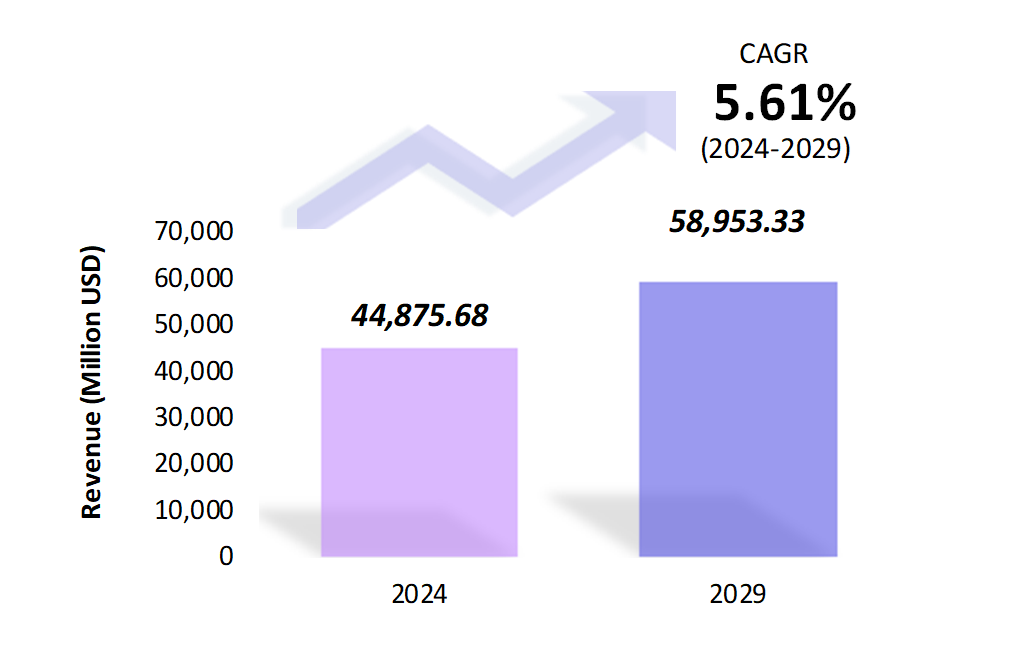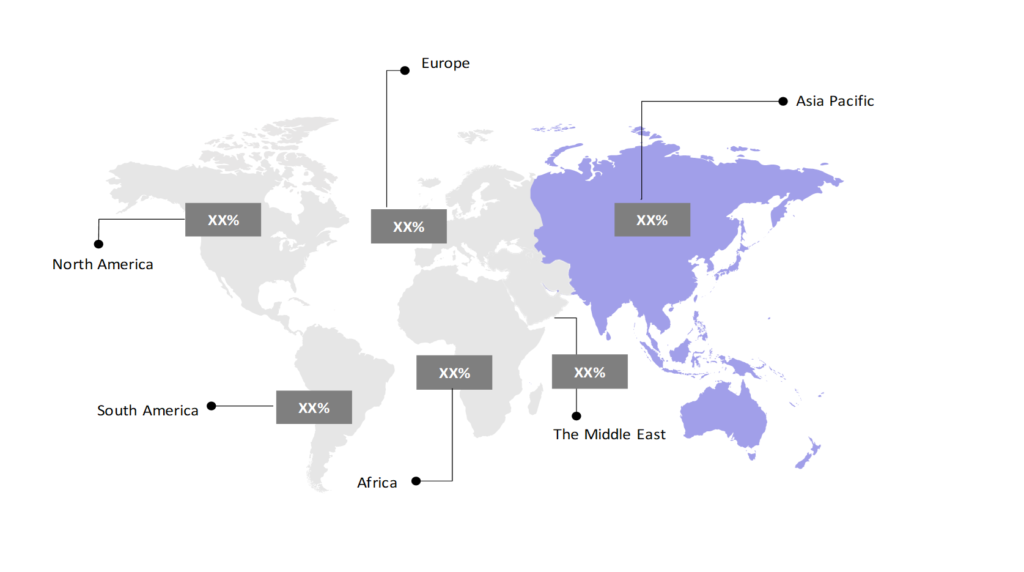Flexible Foam Market Analysis: Growth, Size, Share & Future Trends (2024-2029)
The market report offers a detailed analysis segmented by Type (Polyurethane (PU), Polyethylene (PE), Polypropylene (PP), Others); by Application (Furniture & Bedding, Transportation, Packaging, Others); by Geography (North America, South America, Asia Pacific, Europe, The Middle East, Africa).
Outlook

- The flexible foam market is estimated to be at USD 44,875.68 Mn in 2024 and is anticipated to reach USD 58,953.33 Mn in 2029.
- The flexible foam market is registering a CAGR of 5.61% during the forecast period 2024-2029.
- The global flexible foam market is driven by the increasing demand for lightweight, durable, and energy-efficient materials in various industries. Flexible foam is widely used across industries such as automotive, furniture, bedding, packaging, and construction due to its cushioning, insulation, and shock absorption properties.
Request a free sample.
Ecosystem

- The participants in the global flexible foam industry dominate the market through product innovation, sustainability initiatives, and strong distribution networks.
- These companies primarily focus on sustainable production by using renewable raw materials and recycling technologies, along with forming strategic collaborations to enhance their product offerings and maintain a competitive edge in the market.
- Several important entities in the flexible foam market include BASF SE; Covestro AG; The Dow Chemical Co.; Huntsman International LLC; Zotefoams Plc; and others.
Ask for customization.
Findings
| Attributes | Values |
|---|---|
| Historical Period | 2018-2022 |
| Base Year | 2023 |
| Forecast Period | 2024-2029 |
| Market Size (2024) | USD 44,875.68 Mn |
| Market Size (2029) | USD 58,953.33 Mn |
| Growth Rate | 5.61% CAGR from 2024 to 2029 |
| Key Segments | Type (Polyurethane (PU), Polyethylene (PE), Polypropylene (PP), Others); Application (Furniture & Bedding, Transportation, Packaging, Others); Geography (North America, South America, Asia Pacific, Europe, The Middle East, Africa) |
| Key Vendors | BASF SE; Covestro AG; The Dow Chemical Co.; Huntsman International LLC; Zotefoams Plc |
| Key Countries | The US; Canada; Mexico; Brazil; Argentina; Colombia; Chile; China; India; Japan; South Korea; The UK; Germany; Italy; France; Spain; Turkey; UAE; Saudi Arabia; Egypt; South Africa |
| Largest Market | Asia Pacific |
Get a free quote.
Trends
- Eco-Friendly Materials: Bio-based and recycled materials are gaining prominence in flexible foam production. Manufacturers are prioritizing these sustainable alternatives to meet growing environmental concerns and consumer demands. In 2023, BASF introduced a new line of flexible foam made from plant-based feedstocks, aligning with the global push for sustainable alternatives.
- Focus on Fire Retardancy: Fire-retardant properties are becoming a key focus in flexible foam manufacturing. This trend is driven by the need to comply with increasingly stringent safety regulations across various industries. In 2023, Huntsman Corporation launched a new fire-retardant foam product designed for automotive and building insulation applications.
- Customization and Tailored Solutions: Customized foam solutions are attracting attention in the furniture and automotive sectors. These industries are exploring tailored foam formulations to meet specific design and performance requirements. In 2023, Recticel introduced customizable foam products that allow customers to select foam densities and structures tailored to their specific needs.
Speak to analyst.
Catalysts
- Rising Demand from the Automotive Industry: The automotive sector stands as a major user of flexible foam materials. These foams find extensive application in vehicle seating, cushioning, and insulation components. In 2023, Toyota reported increased demand for foam-based seating materials in its hybrid and electric vehicle models, driving growth in this sector.
- Expansion in Packaging Solutions: Flexible foam is finding increased application in protective packaging solutions. Its superior cushioning and shock-absorbing qualities make it well-suited for safeguarding various products during transit and storage. In 2023, Sealed Air Corporation experienced increased demand for foam-based packaging materials for electronic products, leading to higher market demand.
- Adoption in Medical Applications: Flexible foam is increasingly used in healthcare for medical mattresses, cushions, and prosthetics due to its adaptability, comfort, and pressure-relieving properties. This material offers enhanced patient support and is favored for improving comfort in medical settings. In 2023, Molnlycke Health Care expanded its line of foam-based medical dressings, contributing to the growing demand for flexible foam in the healthcare sector.
Inquire before buying.
Restraints
- Environmental Regulations: Stricter environmental regulations on the use of certain chemicals in foam production, such as volatile organic compounds (VOCs), are creating challenges for manufacturers. In 2023, the European Union tightened its regulations on VOC emissions, forcing manufacturers to invest in greener production technologies.
- Recycling and Disposable Challenges: Recycling flexible foam is challenging, and improper disposal can lead to environmental pollution. Its non-biodegradable nature poses a risk to ecosystems when not properly managed. In 2023, environmental advocacy groups pressured manufacturers like BASF to develop better recycling systems for flexible foam products, leading to increased R&D costs.
- Volatility in Raw Material Price: Volatility in raw material prices, particularly for polyurethane and isocyanates, poses a significant challenge for the flexible foam market. Fluctuating oil prices, which influence these chemicals, can increase production costs and disrupt supply chains. This unpredictability affects pricing strategies and profit margins, making it harder for manufacturers to maintain stable operations.
Personalize this research.
Hotspot

Explore purchase options.
Table of Contents
| 1. Introduction 1.1. Research Methodology 1.2. Scope of the Study 2. Market Overview / Executive Summary 2.1. Global Flexible Foam Market (2018 – 2022) 2.2. Global Flexible Foam Market (2023 – 2029) 3. Market Segmentation 3.1. Global Flexible Foam Market by Type 3.1.1. Polyurethane (PU) 3.1.2. Polyethylene (PE) 3.1.3. Polypropylene (PP) 3.1.4. Others 3.2. Global Flexible Foam Market by Application 3.2.1. Furniture & Bedding 3.2.2. Transportation 3.2.3. Packaging 3.2.4. Others 4. Regional Segmentation 4.1. North America 4.1.1. The US 4.1.2. Canada 4.1.3. Mexico 4.2. South America 4.2.1. Brazil 4.2.2. Argentina 4.2.3. Colombia 4.2.4. Chile 4.2.5. Rest of South America 4.3. Asia Pacific 4.3.1. China 4.3.2. India 4.3.3. Japan 4.3.4. South Korea 4.3.5. Rest of Asia Pacific 4.4. Europe 4.4.1. The UK 4.4.2. Germany 4.4.3. Italy 4.4.4. France 4.4.5. Spain 4.4.6. Rest of Europe 4.5. The Middle East 4.5.1. Turkey 4.5.2. UAE 4.5.3. Saudi Arabia 4.5.4. Rest of the Middle East 4.6. Africa 4.6.1. Egypt 4.6.2. South Africa 4.6.3. Rest of Africa 5. Value Chain Analysis of the Global Flexible Foam Market 6. Porter Five Forces Analysis 6.1. Threats of New Entrants 6.2. Threats of Substitutes 6.3. Bargaining Power of Buyers 6.4. Bargaining Power of Suppliers 6.5. Competition in the Industry 7. Trends, Drivers and Challenges Analysis 7.1. Market Trends 7.1.1. Market Trend 1 7.1.2. Market Trend 2 7.1.3. Market Trend 3 7.2. Market Drivers 7.2.1. Market Driver 1 7.2.2. Market Driver 2 7.2.3. Market Driver 3 7.3. Market Challenges 7.3.1. Market Challenge 1 7.3.2. Market Challenge 2 7.3.3. Market Challenge 3 8. Opportunities Analysis 8.1. Market Opportunity 1 8.2. Market Opportunity 2 8.3. Market Opportunity 3 9. Competitive Landscape 9.1. BASF SE 9.2. Covestro AG 9.3. The Dow Chemical Co. 9.4. Huntsman International LLC 9.5. Zotefoams Plc 9.6. Company 6 9.7. Company 7 9.8. Company 8 9.9. Company 9 9.10. Company 10 |
Know the research methodology.
Flexible Foam Market – FAQs
1. What is the current size of the flexible foam market?
Ans. In 2024, the flexible foam market size is USD 44,875.68 Mn.
2. Who are the major vendors in the flexible foam market?
Ans. The major vendors in the flexible foam market are BASF SE; Covestro AG; The Dow Chemical Co.; Huntsman International LLC; Zotefoams Plc.
3. Which segments are covered under the flexible foam market segments analysis?
Ans. The flexible foam market report offers in-depth insights into Type, Application, and Geography.
